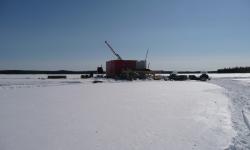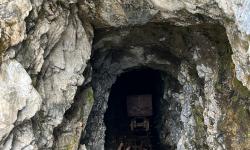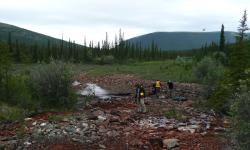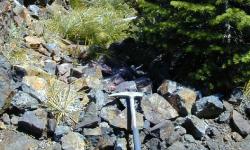Eagle Plains Completes Fieldwork on Titan Property, Discovers High-grade Mineralization
British Columbia | September 11, 2003Cranbrook, B.C.: Eagle Plains Resources Ltd. (EPL:TSX-V) announces that the Corporation has completed the first phase of 2003 fieldwork on it’s Titan property. Field observations and analytical results indicate the presence of a high-grade mineralizing system within the claim area.
The Titan claims are located approximately 50 km west of Atlin, BC at the south end of Tagish Lake. The 32 unit (1944 acre) claim block covers a high grade molybdenum copper porphyry occurrence that has been recently exposed by the retreat of glacial ice. Mineral exploration in the area was initiated in the early 1900’s targeting gold and silver vein occurrences, with the nearby Engineer Mine producing small tonnages from high grade quartz veins. In 1980 United Keno Hill Mines (UKHM) staked the Fee claims in the area of the current Titan claims. The claims saw sporadic work until 1989 and although fieldwork was directed toward assessing gold-silver vein potential, field crews noted that the ongoing retreat of glacial ice at the headwaters of Buchan Creek had begun to expose porphyry copper – molybdenum mineralization. UKHM continued to hold the Fee claims until the late 1990’s when the company was dissolved due to financial duress. The 4 unit Titan claim was staked by an ex UKHM geologist in August 2002 who carried out a one day field program confirming the high grade nature of the molybdenum occurrences. An option to acquire a 100% interest in the claims was acquired by Eagle Plains in late 2002. To earn its interest, Eagle Plains must make cash payments totaling $75,000 and complete exploration expenditures of $150,000 over 5 years. A 1.5% NSR is reserved for the vendor, two thirds (1%) of which may be purchased at any time for $1,000,000.
2003 fieldwork by Eagle Plains included prospecting, rock and soil sampling, and staking of additional claims to cover prospective stratigraphy. Prospecting in the area exposed by retreating glacial ice located massive to disseminated molybdenite in Cretaceous granodiorite boulders and in quartz veins within the granodiorite. By tracing the mineralized boulders upslope, molybdenum mineralization was located in place near the contact between metasediments and Cretaceous granodiorite. This is the first known in situ molybdenum occurrence discovered on the property. Analytical results from high-grade porphyry boulders include CDT03R03, which returned a value of 1.877% molybdenum; CDT03R04, which returned 0.597% molybdenum; and CDT03R07, which returned 1.144% molybdenum. Sample CDT03R08, collected from outcrop, returned a value of 0.966 % molybdenum. A sample of high-grade vein type molybdenum found in float, DOTR01, returned a value of 0.72 % molybdenum. Eight of the ten rock samples collected returned greater than 0.1% molybdenum. Some samples are also associated with elevated copper (up to 2873 ppm), tungsten (up to 93.1 ppm), and bismuth (up to 60.7 ppm)values.
Field observations indicate that higher grade molybdenum mineralization appears to occur along the intrusive – metasedimentary contact zone, with associated chalcopyrite, malachite and a broad zone of disseminated pyrite. Argillic-, sericite- and abundant epidote alteration were noted up to 1 kilometer from the contact zone. The presence of high grade molybdenum mineralization within the limited outcrop exposure combined with an abundance of locally derived high grade float boulders indicate the potential for a large mineralized system.
Molybdenum is a hard, malleable, ductile, high-melting, silver-white corrosion resistant metal. Steel making accounts for about 80% of molybdenum production, with the remainder used in the manufacture of high-speed cutting tools, aircraft parts, forged automobile parts, X-ray tubes, electronic tubes and electric furnaces, rocket and missile parts, lubricants and pigments. British Columbia molybdenum mines and deposits include the Endako Mine (182 Mt at .0785% Mo,) Kitsault Lake (95 Mt at .112% Mo), Boss Mountain (6.7 Mt at 0.13% Mo) and the Adanac (152 Mt at 0.063% Mo) (reference: Geology of Canadian Mineral Deposit types 1995).
Eagle Plains has retained Aurora Geoscience who are currently planning an Induced Polarization geophysical survey program on the Titan property to better define the extent of mineralization along the intrusive – sedimentary contact zone.
On behalf of the Board of Directors
Signed
“Tim J. Termuende”
President and CEO
For further information on EPL, please contact Mike Labach at 1 866 HUNT ORE (486 8673)
Email: mgl@eagleplains.com or visit our website at http://www.eagleplains.com
Cautionary Note Regarding Forward-Looking Statements
Neither the TSX Venture Exchange nor its Regulation Services Provider (as that term is defined in the policies of the TSX Venture Exchange) accepts responsibility for the adequacy or accuracy of this release. This news release may contain forward-looking statements including but not limited to comments regarding the timing and content of upcoming work programs, geological interpretations, receipt of property titles, potential mineral recovery processes, etc. Forward-looking statements address future events and conditions and therefore, involve inherent risks and uncertainties. Actual results may differ materially from those currently anticipated in such statements.
Latest News Releases

Eagle Plains Shareholders Approve all Matters at Annual General Meeting

Eagle Plains’ Partner Refined Energy Corp. Approves 2026 Drill Program for the Dufferin West Project, Saskatchewan

Eagle Plains Reports up to 29.9 g/t Au over 1.8m at the Bulldog Gold – Silver Project, Golden Triangle, BC

Eagle Plains Partner Xcite Resources Commences Airborne Geophysical Surveys at Uranium City Area Projects, Saskatchewan


